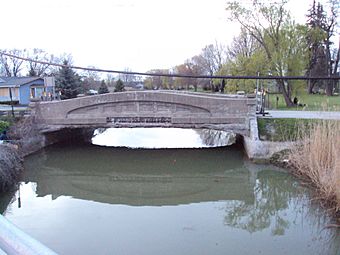Vernier Street–Swan Creek Bridge facts for kids
The Vernier Street–Swan Creek Bridge was a historic bridge in Ira Township, Michigan. It carried Vernier Street over Swan Creek. This bridge was special because it was one of the oldest "curved-chord through girder bridges" left. This type of bridge design was unique to Michigan. The bridge was listed on the National Register of Historic Places in 2000. Sadly, it was taken down in 2014.
Quick facts for kids |
|
|
Vernier Street–Swan Creek Bridge
|
|

Bridge in 2011, prior to demolition
|
|
| Location | Vernier St. over Swan Cr., Ira Township, Michigan |
|---|---|
| Area | less than one acre |
| Built | 1922 |
| Built by | J.E. Mason |
| Architect | Michigan State Highway Department |
| Architectural style | Concrete through girder |
| Demolished | 2014 |
| MPS | Highway Bridges of Michigan MPS |
| NRHP reference No. | 00000011 |
| Added to NRHP | January 28, 2000 |
The Bridge's Story
In 1914, the bridge that was already there over Swan Creek was found to be unsafe. The people living nearby asked the St. Clair County Road Commission for a new bridge.
The Commission started planning. By October 1915, they thought it would cost about $8,000 to build a new one. But the project was put on hold and then canceled in late 1916.
However, the idea for a new bridge came back in 1921 and 1922. The state of Michigan decided to build it. The Michigan State Highway Department built two main bridges over Swan Creek.
Both bridges were 50-foot concrete girder spans. They had a 22-foot wide road for cars. One bridge was built by Rose Construction for about $9,959. The other bridge, at this spot, was built by J. E. Mason for about $11,894.
In 1932, the main state highway, called M-29, was moved to a different path. The small section of road that included this bridge was then renamed Vernier Street. The Vernier Street–Swan Creek Bridge was planned to be taken down in 2014. It was finally demolished in the summer of that year.
What the Bridge Looked Like
The Vernier Street–Swan Creek Bridge was made of concrete. It was a "through-girder" bridge, which means the main support beams were on the sides of the road. These beams had a curved shape at the top.
Each of the strong concrete beams had a special design. They had a panel that was set back, and inside that, there were six smaller panels also set back.
The ends of the main beams rested on slanted supports. Two of these supports had special plaques. These plaques showed that the bridge was a state highway bridge. They also mentioned Frank F. Rogers, who was the commissioner at the time it was built.
The bridge stretched 45 feet across Swan Creek. It had a deck that was 30 feet wide. The part where cars drove was 22 feet wide.



